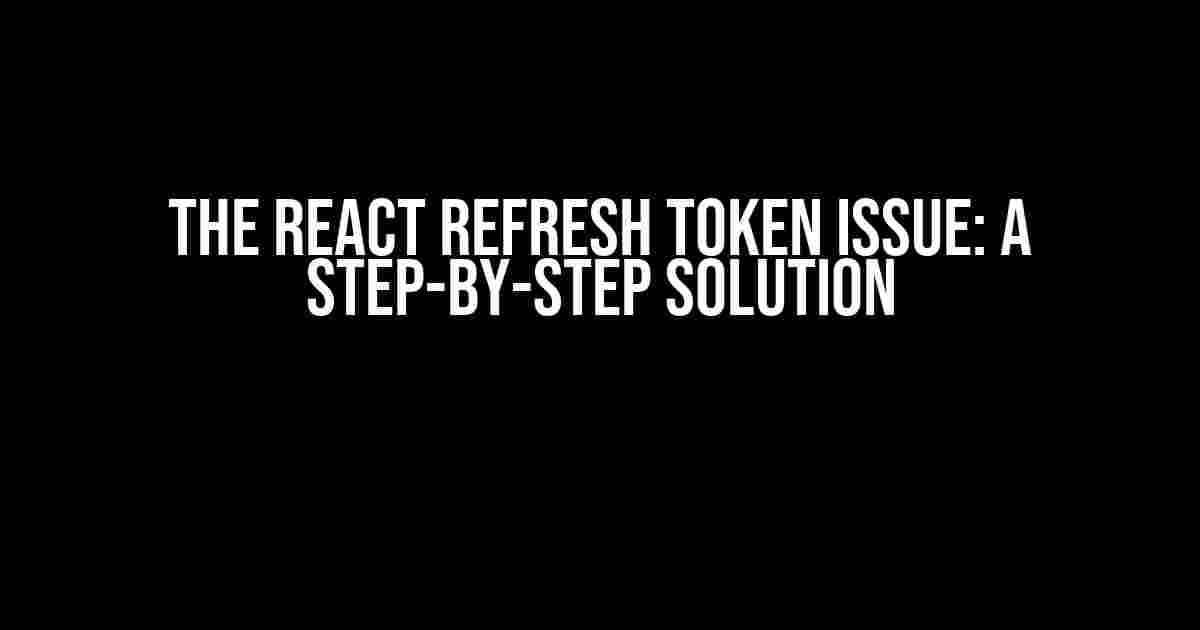If you’re reading this article, chances are you’re frustrated with the React refresh token issue that’s been driving you crazy. You’ve tried everything, from tweaking your API calls to sacrificing your coding soul to the React gods, but nothing seems to work. Fear not, dear developer, for we’ve got you covered. In this comprehensive guide, we’ll walk you through the troubleshooting process, identify the common pitfalls, and provide a clear, step-by-step solution to get your refresh token working seamlessly in your React application.
Understanding the Refresh Token Mechanism
Before we dive into the solution, it’s essential to understand how the refresh token mechanism works. In OAuth 2.0, when you request an access token, it comes with an expiration date. To prevent unauthorized access, the access token is set to expire after a specific period. This is where the refresh token comes in – it’s a special token that allows your application to request a new access token when the existing one expires.
Postman vs. Browser: What’s the Difference?
So, why does your React application work perfectly in Postman but fails miserably in the browser? The answer lies in the way Postman and browsers handle requests. Postman, being a standalone API client, doesn’t enforce the same-origin policy, which allows it to bypass CORS restrictions. On the other hand, browsers are subject to the same-origin policy, which means they follow stricter security guidelines.
Common Pitfalls and Troubleshooting Steps
Before we get to the solution, let’s identify some common pitfalls that might be causing the React refresh token issue:
- Incorrect Token Storage: Are you storing your refresh token securely? Make sure you’re using a secure storage mechanism, such as a cookie or local storage, to store your token.
- Token Expiration: Are you handling token expiration correctly? Ensure that your application is set up to refresh the token when it expires.
- CORS Misconfiguration: Is your CORS configuration correct? Verify that your API server is configured to allow requests from your React application.
- Token Format: Are you using the correct token format? Double-check that your token is in the correct format (e.g., JSON Web Token or opaque token).
Step-by-Step Solution
Now that we’ve identified the common pitfalls, let’s move on to the step-by-step solution:
- Store the Refresh Token Securely:
import { Cookies } from 'react-cookie'; const cookies = new Cookies(); // Set the refresh token in a secure cookie cookies.set('refreshToken', refreshToken, { secure: true, sameSite: 'strict' }); - Handle Token Expiration:
import axios from 'axios'; // Set the authorization header with the access token axios.defaults.headers.common['Authorization'] = `Bearer ${accessToken}`; // Handle token expiration axios.interceptors.push({ responseError: (error) => { if (error.response.status === 401) { // Refresh the token when it expires refreshToken(); } return Promise.reject(error); }, }); - Configure CORS Correctly:
Header Value Access-Control-Allow-Origin * Access-Control-Allow-Headers Content-Type, Authorization Access-Control-Allow-Methods GET, POST, PUT, DELETE Make sure to configure your API server to include these CORS headers in its response.
- Verify Token Format:
Double-check that your token is in the correct format. If you’re using a JSON Web Token (JWT), ensure it’s properly encoded and decoded.
Putting it all Together
Now that we’ve covered the solution, let’s put it all together in a sample React application:
import React, { useState, useEffect } from 'react';
import axios from 'axios';
import { Cookies } from 'react-cookie';
const App = () => {
const [accessToken, setAccessToken] = useState('');
const [refreshToken, setRefreshToken] = useState('');
useEffect(() => {
// Set the authorization header with the access token
axios.defaults.headers.common['Authorization'] = `Bearer ${accessToken}`;
// Handle token expiration
axios.interceptors.push({
responseError: (error) => {
if (error.response.status === 401) {
// Refresh the token when it expires
refreshToken();
}
return Promise.reject(error);
},
});
}, [accessToken]);
const refreshToken = async () => {
try {
const response = await axios.post('/refresh-token', {
refreshToken,
});
const newAccessToken = response.data.accessToken;
const newRefreshToken = response.data.refreshToken;
setAccessToken(newAccessToken);
setRefreshToken(newRefreshToken);
// Store the new refresh token securely
cookies.set('refreshToken', newRefreshToken, { secure: true, sameSite: 'strict' });
} catch (error) {
console.error(error);
}
};
const makeApiCall = async () => {
try {
const response = await axios.get('/api/data');
console.log(response.data);
} catch (error) {
console.error(error);
}
};
return (
);
};
export default App;That’s it! With these steps, you should be able to resolve the React refresh token issue and get your application working seamlessly in the browser. Remember to stay vigilant and troubleshoot each step carefully to ensure a smooth experience.
Conclusion
In conclusion, the React refresh token issue can be frustrating, but with the right approach, it’s easily solvable. By following these steps and understanding the underlying mechanisms, you’ll be well on your way to resolving the issue and building a secure and efficient React application. Happy coding!
If you have any further questions or need additional assistance, feel free to ask in the comments below. We’re here to help!
Don’t forget to share this article with your fellow developers and help spread the knowledge. Happy sharing!
Frequently Asked Questions
Get stuck with React refresh token issues? We’ve got you covered!
Why does my React app work with Postman but not in the browser?
Ah-ha! This is a classic case of “it works on my machine . Check your browser’s console for any errors related to CORS (Cross-Origin Resource Sharing) policies. React apps, by default, run on a different origin (localhost:3000) than your API (localhost:5000, for instance). Postman bypasses these restrictions, which is why it works there but not in the browser. Enable CORS in your API or use a proxy to route requests from your React app to your API.
Is there a way to debug the refresh token issue?
Absolutely! You can use the Network tab in your browser’s DevTools to inspect the requests and responses. Check the request headers for the `Authorization` header, which should contain the Bearer token. Verify that the token is being sent correctly and that the server is responding with a new token upon refresh. You can also use tools like React DevTools or Redux DevTools to monitor state changes and debug the issue.
What could be causing the refresh token to expire unexpectedly?
Hmm, that’s a good question! There are a few possible reasons why your refresh token is expiring earlier than expected. One possibility is that you’re using a short-lived access token, causing the refresh token to expire prematurely. Another reason could be that your token is being invalidated due to changes in the user’s session or permissions. Make sure to check your token configuration and handling to ensure that it’s being properly stored, sent, and validated.
How can I cache the refresh token to prevent frequent requests?
Ah, clever thinking! You can use a caching mechanism like Redux-Persist or React Query to store the refresh token locally. This way, you can retrieve the cached token instead of making a new request to the server every time. Just be sure to handle token expiration and invalidation correctly to avoid using stale tokens.
Any tips for implementing silent token refresh in React?
Ooh, great question! Silent token refresh is a technique to refresh the token in the background without interrupting the user’s workflow. In React, you can use a library like react-query or react-hooks to implement this. Use a timer to trigger a silent refresh when the token is close to expiring. Make sure to handle errors and edge cases properly to ensure a seamless user experience.







